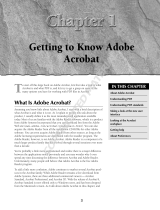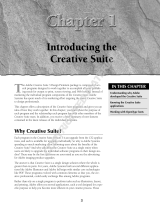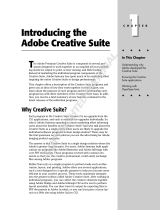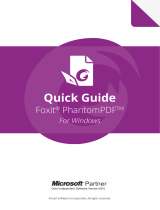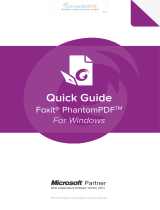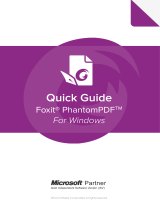Page is loading ...

Adobe® Acrobat® 9 Pro Accessibility Guide:
PDF Accessibility Overview

Adobe, the Adobe logo, Acrobat, Acrobat Connect, the Adobe PDF logo, Creative Suite, LiveCycle, and Reader are either registered trade-
marks or trademarks of Adobe Systems Incorporated in the United States and/or other countries. AutoCAD is either a registered trade-
mark or a trademark of Autodesk, Inc., in the USA and/or other countries. GeoTrust is a registered trademark of GeoTrust, Inc. Microsoft
and Windows are either registered trademarks or trademarks of Microsoft Corporation in the United States and/or other countries. All
other trademarks are the property of their respective owners.
© 2008 Adobe Systems Incorporated. All rights reserved.

Making PDF Accessible with Adobe Acrobat 9 Pro
| i
Introduction 1
PDF Accessibility 1
Each PDF File is Different 1
Two Workflows for Creating Accessible PDF Files 1
Characteristics of Accessible PDF files 1
Searchable text 2
Fonts that allow characters to be extracted to text 2
Interactive form fields 2
Other Interactive Features: Buttons, hyperlinks, and navigational aids 2
Document language 2
Security that will not interfere with assistive technology 2
Document structure tags and proper read order 2
Alternative text descriptions 2
Adobe Acrobat and Adobe Reader Accessibility Features 3
Features for Accessible Reading of PDFs 3
Features for Creating Accessible PDFs 3
The Acrobat 9 Pro Accessibility Guide Series 4
PDF Accessibility Overview (this document) 4
Creating Accessible PDF from Microsoft® Word 4
Acrobat 9 Pro PDF Accessibility Repair Workflow 5
Using the Accessibility Checker in Acrobat 9 Pro 5
Creating Accessible PDF Forms with Acrobat 9 Pro 5
Acrobat 9 Pro Complete Best Practices for Accessibility 5

Making PDF Accessible with Adobe Acrobat 9 Pro
ii |

Adobe Acrobat 9 and PDF Accessibility
1
Introduction
PDF Accessibility
A document or application is accessible if it can be used by people with disabilities—such as mobility
impairments, blindness, and low vision—and not just by people who can see well and use a mouse.
Accessibility features in Adobe Acrobat, Adobe Reader, and Adobe Portable Document Format (PDF) make
it easier for people with disabilities to use PDF documents and forms, with or without the aid of assistive
software and devices such as screen readers, screen magnifiers, and braille printers.
Making PDFs accessible tends to benefit all users. For example, the underlying document structure that
makes it possible for a screen reader to properly read a PDF out loud also makes it possible for a mobile
device to correctly reflow and display the document on a small screen. Similarly, the preset tab order of an
accessible PDF form helps all users—not just users with mobility impairments—fill the form more easily.
Each PDF File is Different
Not all PDFs are the same. PDF files are created in a variety of ways, from a variety of applications, and for a
variety of purposes. In addition to applying the proper accessibility enhancements to PDF documents,
achieving your accessibility goals for an individual PDF file requires understanding the nature of the PDF
and the uses for which it is intended.
Using the guide Adobe® Acrobat® 9 Pro Accessibility Guide: PDF Accessibility Repair Workflow, you will learn
how to assess existing PDF files for certain characteristics which influence their accessibility. The order in
which this assessment is conducted is important. By following these procedures in the recommended order,
users can efficiently proceed through the analysis of a PDF file in a systematic fashion. Systematically ruling
out or confirming certain characteristics which a PDF file may possess will guide you to the most
appropriate next step for making an individual PDF accessible.
This series also discusses techniques for converting source files to accessible PDF. Using the Adobe
PDFMaker with Microsoft Word as an example, this guide provides best practices for designing your source
document with accessibility in mind so that the original document can be efficiently transformed into an
accessible PDF version. Refer to the guide entitled Adobe® Acrobat® 9 Pro Accessibility Guide: Creating
Accessible PDF from Microsoft® Word for complete information.
Note: These Best Practices techniques assume the user has access to Adobe Acrobat Pro 9 or
Adobe Acrobat 9 Pro Extended for Windows. Adobe Reader 9 and Adobe Acrobat 9
Standard do not have the complete set of tools needed to create and validate PDF
documents for accessibility.
Two Workflows for Creating Accessible PDF Files
The PDF format is a destination file format. PDF files are typically created in some other application. What
this means is that the author who is concerned with PDF accessibility will be confronted with one of two
situations:
• Individuals working with an existing PDF file will want to know how to edit/update it to be
an accessible PDF file.
• Authors will want to know how to use some other software application, such as a word processing
or desktop publishing application, to generate an accessible PDF file from that application if
possible.
Characteristics of Accessible PDF files
The Adobe Portable Document Format (PDF) is the native file format of the Adobe® Acrobat® family of
products. The goal of these products is to enable users to exchange and view electronic documents easily and

Introduction
Adobe Acrobat 9 and PDF Accessibility
2 |
reliably, independently of the environment in which they were created. PDF relies on the same imaging
model as the PostScript® page description language to describe text and graphics in a device-independent
and resolution-independent manner. To improve performance for interactive viewing, PDF defines a more
structured format than that used by most PostScript language programs. PDF also includes objects, such as
annotations and hypertext links, that are not part of the page itself but are useful for interactive viewing and
document interchange.
Accessible PDFs have the following characteristics:
Searchable text
A document that consists of scanned images of text is inherently inaccessible because the content of the
document is a graphic representing the letters on the page, not searchable text. Assistive software cannot
read or extract the words in a graphic representation, users cannot select or edit the text, and you cannot
manipulate the PDF for accessibility. You must convert the scanned images of text to searchable text using
optical character recognition (OCR) before you can use other accessibility features with the document.
Fonts that allow characters to be extracted to text
The fonts in an accessible PDF must contain enough information for Acrobat to correctly extract all of the
characters to text for purposes other than displaying text on the screen. Acrobat extracts characters to
Unicode text when you read a PDF with a screen reader or the Read Out Loud tool, or when you save as text
for a braille printer. This extraction fails if Acrobat cannot determine how to map the font to Unicode
characters.
Interactive form fields
Some PDFs contain forms that a person is to fill out using a computer. To be accessible, form fields must be
interactive—meaning that a user must be able to enter values into the form fields. Interactive PDF forms also
have a defined tab order allowing users of assistive technology to use the tab key in order to progress from
one form field or interactive control in a logical manner. Refer to the document Adobe® Acrobat® 9 Pro
Accessibility Guide: Creating Accessible Forms for complete details.
Other Interactive Features: Buttons, hyperlinks, and navigational aids
Navigational aids in a PDF—such as links, bookmarks, headings, a table of contents, and a preset tab order
for form fields—assist all users in using the document without having to read through the entire document,
word by word. Bookmarks are especially useful and can be created from document headings. Many of these
aids can be accessed using the keyboard without relying on the mouse.
Document language
Specifying the document language in a PDF enables some screen readers to switch to the appropriate
language.
Security that will not interfere with assistive technology
Some authors of PDFs restrict users from printing, copying, extracting, adding comments to, or editing text.
The text of an accessible PDF must be available to a screen reader. You can use Acrobat to ensure that
security settings don’t interfere with a screen reader’s ability to convert the on-screen text to speech.
Document structure tags and proper read order
To read a document’s text and present it in a way that makes sense to the user, a screen reader or other text-
to-speech tool requires that the document be structured. Document structure tags in a PDF define the
reading order and identify headings, paragraphs, sections, tables, and other page elements.
Alternative text descriptions
Document features such as images and interactive form fields can’t be read by a screen reader unless they
have associated alternative text. Though web links are read by screen readers, you can provide more

Introduction
Adobe Acrobat 9 and PDF Accessibility
| 3
meaningful descriptions as alternative text. Alternative text and tool tips can aid many users, including those
with learning disabilities.
Adobe Acrobat and Adobe Reader Accessibility Features
Accessibility features in Adobe Acrobat 9 and Adobe Reader 9 fall into two broad categories: features to
make the reading of PDF documents more accessible and features to create accessible PDF documents. To
create accessible PDF documents, you must use Acrobat, not Reader.
Features for Accessible Reading of PDFs
• Preferences and commands to optimize output for assistive software and devices, such as saving as
accessible text for a Braille printer
• Preferences and commands to make navigation of PDFs more accessible, such as automatic
scrolling and opening PDFs to the last page read
• Accessibility Setup Assistant for easy setting of most preferences related to accessibility
• Keyboard alternates to mouse actions
• Reflow capability to temporarily present the text of a PDF in a single easy-to-read column
• Read Out Loud text-to-speech conversion.
• Support for screen readers and screen magnifiers
Features for Creating Accessible PDFs
• Creation of tagged PDFs from authoring applications
• Conversion of untagged PDFs to tagged PDFs from within Acrobat
• Security setting that allows screen readers to access text while preventing users from copying,
printing, editing, and extracting text
• Ability to add text to scanned pages to improve accessibility
• Tools for editing reading order and document structure
• Tools for creating accessible PDF forms
Though Acrobat Standard provides some functionality for making existing PDFs accessible, you must use
Acrobat Pro or Acrobat Pro Extended to perform certain tasks—such as editing reading order or editing
document structure tags—that may be necessary to make some PDF documents and forms accessible (See
“Table 1: Features for Creating Accessible PDF Files by Product” on page3).
Table 1: Features for Creating Accessible PDF Files by Product
Reader 9
Acrobat 9
Standard
Acrobat 9
Pro
Acrobat 9
Pro
Extended
Create PDF documents from any
application that prints
• • •
Convert Microsoft Word, Excel,
PowerPoint, Publisher, and
Access files to PDF with one-
button ease*
• • •
* Windows Only

Introduction
Adobe Acrobat 9 and PDF Accessibility
4 |
The Acrobat 9 Pro Accessibility Guide Series
To assist those who use Adobe Acrobat 9 Pro to create PDF files with the production of content that is
accessible to people with disabilities, Adobe Systems has created a series of accessibility guides for Adobe
Acrobat 9 Pro.
PDF Accessibility Overview (this document)
The Adobe® Acrobat® 9 Pro Accessibility Guide: PDF Accessibility Overview details what is meant by
accessibility when considering the PDF file format. It distinguishes between the accessibility features of the
the file format and the accessibility features of the Adobe Acrobat 9 and Adobe Reader application and how
the features of the software and the file format interact to achieve accessibility for people with disabilities.
Creating Accessible PDF from Microsoft® Word
The Adobe® Acrobat® 9 Pro Accessibility Guide: Creating Accessible PDF from Microsoft® Word provides an
example using Microsoft Word of how to use Acrobat’s PDFMaker to make accessible PDF files from the
Capture web pages as rich,
dynamic PDF files for review
and archiving
• • •
Scan paper documents to PDF
and automatically recognize text
with optical character recogni-
tion (OCR)
• • •
Save PDF files as Microsoft
Word documents, retaining the
layout, fonts, formatting, and
tables, to facilitate reuse of con-
tent
• • •
Easily create fillable PDF forms
from paper or existing files using
the Form Wizard
• • •
Enable users of Adobe Reader®
(version 8 or later) to fill in and
save PDF forms locally
• • •
Create dynamic XML forms with
Adobe LiveCycle® Designer ES
(included)*
• •
Create and validate accessible
PDF documents
• •
Table 1: Features for Creating Accessible PDF Files by Product (Continued)
Reader 9
Acrobat 9
Standard
Acrobat 9
Pro
Acrobat 9
Pro
Extended
* Windows Only

Introduction
Adobe Acrobat 9 and PDF Accessibility
| 5
popular word processing application. Some of the techniques apply to the Microsoft Office productivity
suite as well, such as PowerPoint® presentation graphics program.
Acrobat 9 Pro PDF Accessibility Repair Workflow
The Adobe® Acrobat® 9 Pro Accessibility Guide: PDF Accessibility Repair Workflow provides a step-by-step
method for analyzing existing PDF files and making them accessible based upon that analysis.
Using the Accessibility Checker in Acrobat 9 Pro
The Adobe® Acrobat® 9 Pro Accessibility Guide: Using the Accessibility Checker describes the accessibility
checkers for PDF files that are included in Adobe Acrobat 9 Pro. Even if you generate an accessible PDF file
from an authoring application such a word proccessing application or desktop publishing program, you
should then follow the steps in this guide in order to identify any items that may have been missed in the
initial conversion or to add PDF accessibility features that are not provided by the authoring tool.
Creating Accessible PDF Forms with Acrobat 9 Pro
The guide entitled Adobe® Acrobat® 9 Pro Accessibility Guide: Creating Accessible Forms describes how to use
the forms tools within Adobe Acrobat 9 Pro to add descriptions to form fields, tag untagged forms, set the
tab order, manipulate tags, and perform other PDF accessibility tasks. These techniques do not apply to PDF
forms from Adobe LiveCycle Designer.
Acrobat 9 Pro Complete Best Practices for Accessibility
The complete content of the individual guides is also available as a single, comprehenive document entitled
Adobe® Acrobat® 9 Pro Accessibility Guide: Best Practices for Accessibility.

Introduction
Adobe Acrobat 9 and PDF Accessibility
6 |
/
